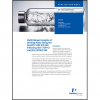
Scientists in Ireland recently tested the effectiveness of different machine learning (ML) methods for measuring contamination levels on wind turbine blades. Their work was published in Spectrochimica Acta Part B: Atomic Spectroscopy (1).
Wind energy has become a popular alternative to fossil fuels. In addition to not releasing emissions that can pollute the air or water, wind turbines can reduce electricity generation from fossil fuels, causing a decrease in total air pollution and carbon dioxide emissions (2). However, contamination can have a detrimental effect on wind turbine performance. Contaminants can be organic (insects, birds, plant matter) or inorganic (soil, sand, salt). This has led to a push for cleaning processes that are efficient, cost-effective, and non-hazardous.
In this study, the scientists investigated standoff laser ablation as a means of cleaning wind turbine blades, specifically in combination with standoff laser-induced breakdown spectroscopy (LIBS). This use of LIBS has been used for material analysis in different fields, such as historical architecture and infrastructure testing; meanwhile, laser ablation has been used to investigate archaeological artifacts, biological materials, and more.
The scientists combined these techniques to investigate the surface of wind turbine blade materials and detect contamination pre- and post-cleaning. This involved performing LIBS in the vacuum ultraviolet (VUV) and ultraviolet visible (UV-Vis) spectral ranges. Analyzing the spectra only showed slight variations in constituent materials between clean and contaminated blade samples. To create a more efficient method of distinguishing between clean and contaminated samples, four different machine learning (ML) and statistical methods were evaluated: partial least squares discriminant analysis (PLS-DA), support vector machines (SVM), competitive learning (CL), and convolutional neural networks (CNN). Additionally, the spectral regions where the algorithms were applied were chosen via a volumetric ellipsoid overlap test based on principal component analysis (PCA).
The scientists found that SVM performed the best, followed by PLS-DA, CNN, and finally, CL. The SVM approach showed high accuracy and precision, and when projected via PCA, the LIBS spectra became linearly separable. The other techniques did perform well but were slightly less accurate and longer in run time than SVM, the scientists wrote (1). The researchers intend to further compare and evaluate other ML algorithms and address challenges for incorporating this setup into portable systems for field deployment.
References
(1) Cummins, S.; Campbell, J. N.; Durkan, S. M.; Somers, J.; Finnegan, W.; Goggins, J.; Hayden, P.; Murray, R.; Burke, D.; Lally, C.; Alli, M. B.; Varvarezos, L.; Costello, J. T. Wind turbine contaminant classification using machine learning techniques. Spectrochim. Acta Part B At. Spectrosc. 2023, 210, 106802. DOI: https://doi.org/10.1016/j.sab.2023.106802
(2) Wind explained: Wind energy and the environment. U.S. Energy Information Administration. 2023. https://www.eia.gov/energyexplained/wind/wind-energy-and-the-environment.php (accessed 2023-11-27)












